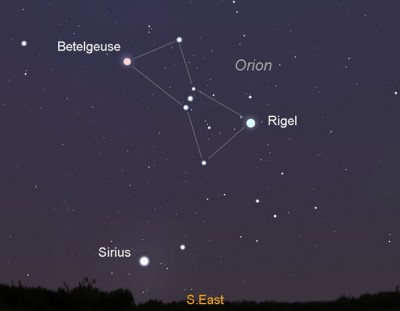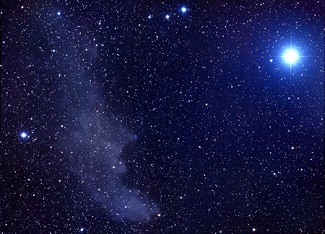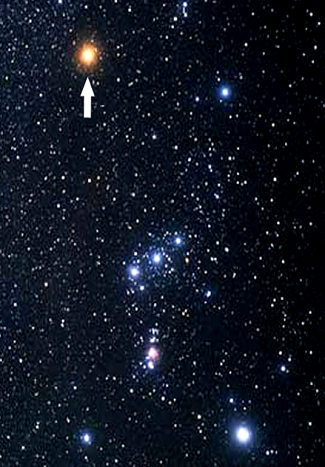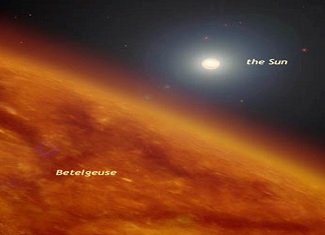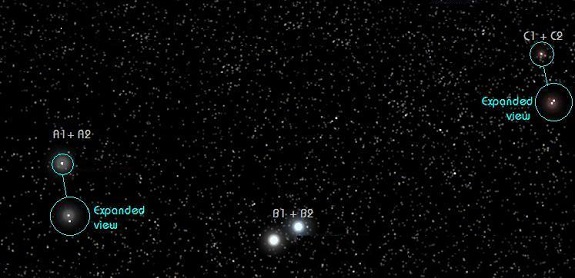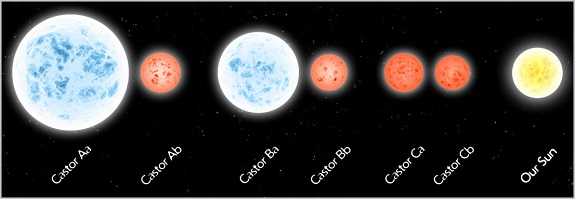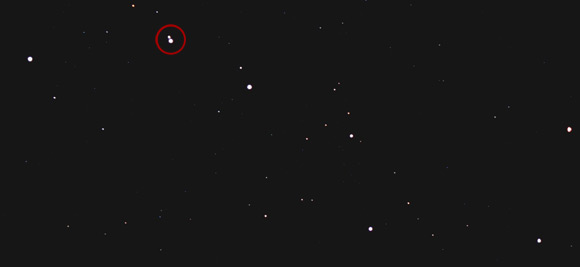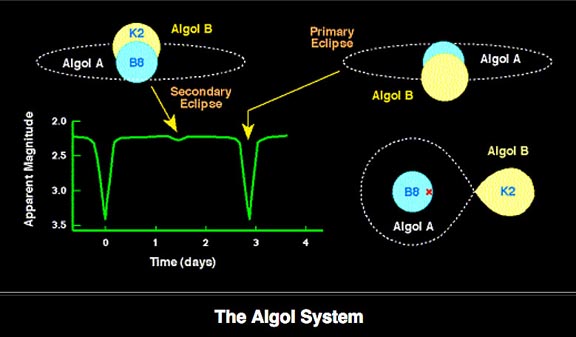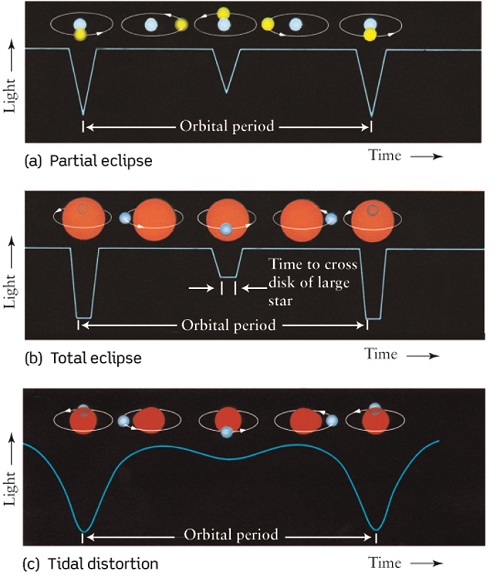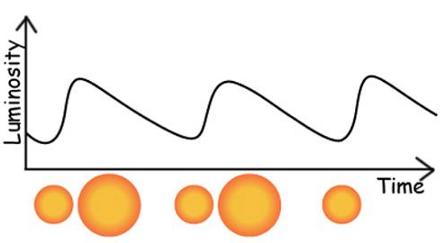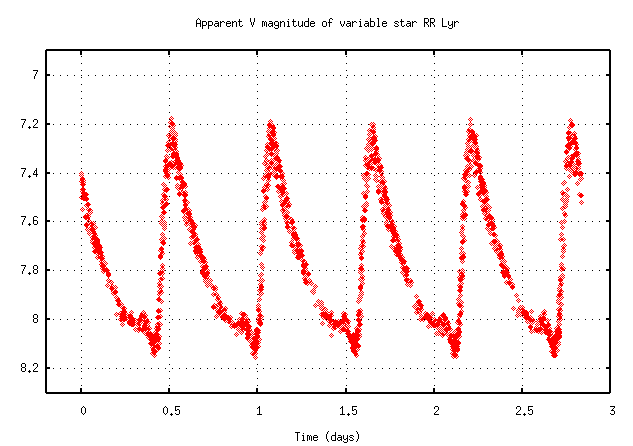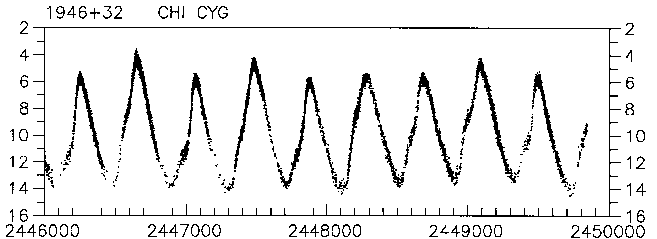The StarsAs we examine the night sky, we notice there are some stars that appear brighter than others, and some even seem to have a color attached. We know that the "wandering stars" of the past are planets. But what about the others? As pointed out in the Milky Way page on stars, there are two basic groups: Population I and Population II stars. Population II are the older and found in the centers of galaxies and in the globulars clusters in the halos of galaxies. They are dominated by the red giants. Population I stars, like our sun, are younger and found in the spiral arms of galaxies. They are dominated by the very hot blue giants. Some prominent stars are blue giants, like Rigel, in Orion. It's about 773 light years away from us, so we know it is very bright. Rigel is a binary star. That means it has a faint companion and they orbit each other.
A good page of information with a great video is on an EarthSky page. On the other side of the Orion Constellation is Betelgeuse, a giant red star.
Why is one blue and one red? It is because of the temperatures of the stars. The hotter the star, the bluer it is. Think of heating an iron bar. As it starts to get hot, it will glow a dull red. The hotter it gets, the brighter it gets and the color gradually changes to orange, then yellow, then to white and finally to blue when it is very, very hot. Stars show different colors for the same reasons. Rigel is 19,000 degrees F., while Betelgeuse is "only" 6000 degrees F. Are Rigel and Betelgeuse the same distance from us? They are both in the constellation of Orion. No, they are not the same distance away from us. Rigel is about 860 light years away and Betelgeuse is 643 light years away. The reason they look the way they do, in one constellation, is because of where we are in relationship to them, not where they are in relationship to each other. Like Rigel, many stars that seem to us to be simply one bright point of light are actually double or multiple stars when seen through a telescope. Whether double or multiple, however, these stars are all orbiting each other and are astronomically close together, ranging from almost in contact to about 11 AU apart (Pluto is 40 AU from the sun, so you can see how close these stars are to each other). The University of Oregon has an excellent discussion of binary stars. Star Systems Then there are systems such as the Castor System, in Gemini. Castor appears to us as one star with its companion Pollux.
In reality, Castor involves six stars in three close binary systems. The pairs are only about 104 AU apart from each other. The binary systems not only involve a pair of stars orbiting each other, but the pairs themselves are going around each other. The first two binary pairs orbit each other about every 445 years. The third binary pair orbits the first two in a wider orbit, as shown below. It takes about 10,000 years to orbit the A and B pairs.
The A pair of the Castor system are closer together than Mercury is to our sun. They are only about 2 million miles apart. They only take a little over nine days to circle each other. The B pair have an average distance apart from each other that's a little more: about 2.8 million miles apart. That is still closer than Mercury to the sun. They orbit each other every 2.9 days. The C pair are the closest to each other, at only 1.6 million miles apart. They whip around each other in 19.5 hours. Castor is only an example of the many star systems we have found. The Mizar System in the handle of the Big Dipper is another example. With keen eyesight, a second star, Alcor, can be seen. In a small telescope, Mizar appears as two stars and Alcor becomes a third star. However, with stronger telescopes, it becomes evident that each one of these three is actually a pair, a binary system.
Variable Stars There is a very good introduction to variable stars in a recent article at Space.com:
We highly recommend Natalie Wilson's page on variables. A sophomore in high school, we sincerely hope she got an A in the course! There are two reasons a star may be variable -- reasons outside itself (extrinsic) or because of itself (intrinsic).
We will only be looking at a few of these types. Extrinsic Variables: A star may appear to vary in brightness if another star (an eclipsing binary) or a planet crosses in front of it and dims it from our point of view. These forms of variable stars are quite regular in their variability, as they are appearing dimmer due to another object which is rotating around it. A good example of an eclipsing binary is Algol.
In the above diagram, the light from BOTH stars is being measured. When there is a primary eclipse, and one star disappears almost entirely behind another, there is a big dip in the brightness, or magnitude. When there is only a secondary eclipse, and the smaller star passes in front, the larger star is still adding most of its brightess to the whole and so there is only a minor dip in magnitude. This partial eclipse dip is seen much more dramatically in the Beta Lyrae System:
The upper two sections of this illustration should be clear -- the partial and total eclipse. But in this system we are also seeing something else -- the dip in the middle is smooth in the lowest illustration. The reason for this is that the two bodies are so close they are exchanging mass, and that exchange is resulting in the smoothness of the curve as it adds its magnitude to the whole during the eclipse. If you look carefully at the lowest diagram, and notice the red balls which are second and second to the last, you will see a bulge in the larger body as the artist is indicating the gravitational pull which is causing the mass exchange. Here is a photograph of that system. You can see the distortion in both bodies because they are so close together.
Although there are other types of variables which are classified as extrinsic, their variability actually has something to do with the star itself and therefore we feel should be classified with the intrisic variables. They will be listed first. Intrinsic Variables Stellar Spots -- usually classified with extrinsic. These variables show small changes in magnitude as they rotate due to what we might call "sunspots." Some of these dark spots may cover the best part of a star's hemisphere. As the dark spot faces us, the light from the star dims. Rapidly rotating variables -- usually classified with extrinsic. Although all stars rotate, these rotate so rapidly they become ellipsoidal, or football-shaped. Thus, as a broader side is turned to us, it will appear brighter than when "end on." Magnetic field variables -- usually classified with extrinsic. Strong magnetic fields can cause bright spots in the chromosphere of a star. In many cases, these bright spots appear at the poles, where the magnetic field exits. If the star is turned so that the magnetic poles are rotating toward and then away from us, we will see changes in brightness. The following are classified universally as intrinsic variables. There are many classifications of this type, but only a few major ones will be presented here. Pulsating Variable Stars -- these stars have a tendency to change size at regular intervals, swelling and contracting, which gives a significant change in their perceived magnitude. As radiation pressure builds inside the star's near-surface layers, the layers expand out, allowing the radiation to escape. The outer layers then collapse back down. This is somewhat like a pot with a lid on a hot stove. When the water starts to boil, the lid will start popping up and down and steam needs to be released. This popping happens very quickly on a stove, but more slowly with a star. When the star is smaller, it appears brighter. When it is swelling, it actually appears somewhat dimmer.
There are several varieties of these pulsating variable stars, each with their own characteristic light curve. Cepheid Variables: These are very bright stars, and so can be seen from great distances. Their luminosity ranges from 300 to 40,000 times that of our sun. They are Population I stars, found in the spiral arms of galaxies. They have a characteristic light curve, called a shark fin curve, different from all other intrinsic variables.
Here is what is happening to the star itself. The period of variability for different cepheids ranges from two days to sixty days.
The characteristics of these stars allow us to tell distances in space. Here is how it works:
We can use Cepheids to measure distance out to 150 million light years. Below is a photograph of our galaxy where two cepheids are known to exist in relation to the galactic center: RR Lyrae Variables: Originally called "cluster variables" these stars are Population II stars usually found in globular clusters and in the halos of galaxies. They are about half the mass of our sun, but much hotter. Like Cepheid Variables, they also pulsate inward and outwards. They can be up to 80 times the luminosity of the sun, with a period of variability from four hours up to one day. Even though they are not as bright as the Cepheids, we can still use them to help determine distances, because their periods of variability are directly linked to their luminosity. They can be used throughout our galaxy and in our Local Group of galaxies to determine distances. It was through them that the the spiral nebula in Andromeda was confirmed as being 2.5 million light years away. We used Cepheids to cross-check this. RR Lyraes can be used to determine distances out to about 3 million light years away. Three of the RR Lyrae Variables in the globular cluster M55 (one of the Milky Way's globular clusters) are pointed out below.
As can be seen above, the shape of the peaks for these stars is quite different from the Cepheids. The amplitudes (peaks) are very high and sharp with these, and there is a sort of hump at the bottom before it reaches its low point. Mira Variables: These are huge red giant Population II stars found in the cores and halos of galaxies. They have long periods of variability, from 80 to 1000 days. Mira itself, after which these stars are named, is around 330 days in its cycle.
Mira Variables are generally less that two times the mass of our sun, but are thousands of times brighter. Like the other two variable stars mentioned so far, there is a direct relationship between their period of variation and their luminosity. Their changes in brightness, however, are more dramatic.
These stars are not all the same. Some change their periods of variability and they are of different chemical compositions and masses. Because some can change their periods of variability, they are known as irregular variables. Eruptive Variables: These stars tend to be dramatic. They are characterized by violent outbursts due to various causes. For some small stars, there may be just a massive flare on its surface which changes its brightness dramatically for a short period of time. For others, the entire star may explode into a supernova. Here are some of the examples: Supernovae – These massive stars show sudden, dramatic, and final magnitude increases of 20 magnitudes or more, as a result of a catastrophic stellar explosion.
Nova Star -- this is a star that explosively expels material from its surface. This increases its brightness dramatically for several months. In some cases, the process repeats after a period of time (decades to centuries), causing these to be called "recurrent novae."
Other Eruptive variables are stars varying in brightness because of violent processes and flares occurring in their chromospheres and coronae. The light changes are usually accompanied by shell events or mass outflow in the form of stellar winds of variable intensity and/or by interaction with the surrounding interstellar medium. A typical example is R Coronae Borealis. Although we strongly disagree with stars being element-makers, as the linked article suggests, AstroBob has presented a great page on R Coronae Borealis which is worth reading, and the pictures worth seeing. Another example of an eruptive variable, and an unusual one, is Eta Carinae. It is in a rare class called luminous blue variables, and this one can be clearly seen in the sky of the Southern Hemisphere. Most amateur astronomers in Australia check this star nightly to see if it has brightened or even exploded. The linked article is very good. Not all stars are as remarkable as the classes of stars discussed above. Most, like our sun, are simply stars. More about 'normal' stars can be found on the Explanations and Interpretations page on Stars.
|
